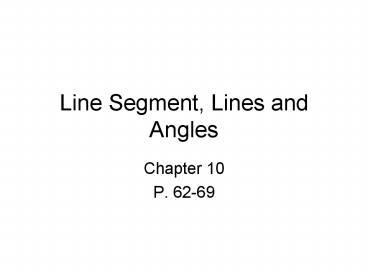Line Segment, Lines and Angles - PowerPoint PPT Presentation
1 / 30
Title:
Line Segment, Lines and Angles
Description:
If we join them with a straight edge, we have a line segments. ... An angle that is greater than 90 but less than 180 is called an obtuse angle. ... – PowerPoint PPT presentation
Number of Views:1403
Avg rating:3.0/5.0
Title: Line Segment, Lines and Angles
1
Line Segment, Lines and Angles
- Chapter 10
- P. 62-69
2
Mark two points on a sheet of paper which is a
representation of a plane in geometry. If we
join them with a straight edge, we have a line
segments. The two points we marked are called
end points. If we name these two points A and B
we get a line segment AB as shown below.
A
B
3
A line segment AB is written as
4
You can use a ruler for measuring length and
drawing line segments.Make sure the measurement
of length starts at 0 not at the end of the
ruler!
5
If we extend the line segment AB in both
directions indefinitely (i.e. on and on without
end), we will get what we call, in geometry, a
line. A line AB, written as may be
represented like this.
A
B
6
If we extend the line segment AB in either
direction indefinitely, we will get a ray ABor
BA
A
B
B
A
7
The line segment AB, line AB, ray AB or the
length of AB may simply be written as AB.
Instead of using different ways to show them in
drawings, we may simply represent them like this
A
B
8
In our surroundings, we find many everyday life
examples that suggest the idea of an angle. Here
are some of them.
9
We can view an angle as the rotation of a ray
from one position to another.
10
How do we name an angle?
B
C
A
11
The point A is called the vertex of the angle.
AB and AC are called the sides or arms of the
angle. We name this angle BAC or angle CAB.
Angle BAC is written . Angle CAB is
written .
B
Notice that when we name an angle, we always put
the letter for the vertex in the middle.
C
A
12
Another way of naming an angle is to use one
letter of the alphabet as shown in the diagram.
This angle is written as .
p
13
How do we measure an angle?
14
To measure the size of an angle, we use a
protractor. The protractor is a semicircle with
markings on it. The center of the circle is the
midpoint of the base line.
15
To measure an angle using a protractor, follow
these steps1. Place the center point of the
protractor on the vertex of the angle to be
measured.2. Align the base line (no the base
edge) of the protractor with one arm of the
angle.3. Read the appropriate scale, that is,
the scale that starts with 0 from the aligned
arm.
16
What are the different types of angles?
17
An angle of 90 is called a right angle.
A right angle is usually marked with a small
square corner as shown to the left.
90
18
An angle of less than 90 is called an acute
angle.
19
An angle that is greater than 90 but less than
180 is called an obtuse angle.
20
An angle that is greater than 180 but less than
360 is called a reflex angle.
21
Consider the following situationIf a boy
facing north makes a quarter of a revolution
(clockwise) so that he faces east while standing
on the same spot, what is the size of the angle
made by him?
22
What if he makes three quarters of a revolution
(counterclockwise), he will also face east. What
angle has he made?
23
Suppose we are given two pairs of angles - 25,
65 and 70, 20. Have you noticed that the
sum of each pair of angles is 90?
24
Two angles are said to be complementary if their
sum is 90.The angles 25, 65 and 70, 20 are
complementary angles.
25
If two angles are complementary, each angle is
called the complement of the other.
26
Two angles are said to be supplementary if their
sum is 180. For example, 151 and 29 are
supplementary angles. The angles 55 and 125
are also supplementary angles.
27
If two angles are supplementary, each angle is
called the supplement of the other.
28
An angle bisector is a line or line segment that
divides an angle into two halves.
A
P
O
B
29
If OP divides into equal parts, i.e.
, or , then OP is
the angle bisector of .
A
P
O
B
30
Tonights homeworkWorkbook Activity 10A on
page 27 in Workbook B































